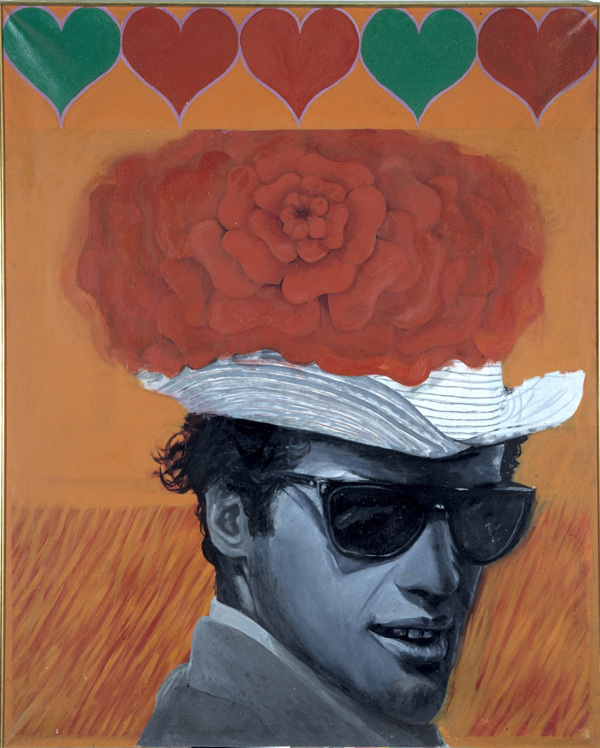The Pop Art painting I have choose is entitled With love to Jean-Paul Belmondo and was made by Pauline Boty in 1962. In this Pop Art Portrait, we can see the succesful french actor Jean-Paul Belmondo painted in shades of grey, wearing sunglasses and a white stripped hat with a giant red flower on the top, and on top of it we can see five hearts (two green hearts and three red hearts). The whole is on an orange background with thin red stains at the bottom.
There are many ways in which this painting can be related to the notion of myths and heroes. The first one that came to my mind was Pauline Boty, the artist.
Pauline Boty (1938-1966) was the only female artist in the British Pop Art movement. Through her artistic productions (which included paintings and collages) she claimed the assertion of female sexuality in a society she described as a "Man's world", and in which she felt trapped in as an artist woman. Her rebellious art, combined with her free-spirited lifestyle, has made Pauline Boty a herald of 1970's feminism, following the steps of an ideology that had already been previously settled by other artists such as writers Sylvia Plath, Simone de Beauvoir and Virginia Woolf.
We may consider her as a hero to some extent, since she took an active part in an artistic movement in which the main contributors were men (Andy Warhol, Richard Hamilton, Jasper Johns…) and was not intimidated by that fact whatsoever. She also became a a myth because of her early death caused by a cancer during her pregnancy: Pauline refused to take any medication that might have harmed the foetus and therefore died soon after giving birth to her daughter. She was only 28 years old, and thus we might consider her artistic productions as unachieved. We will never know what she might have painted all along her life if she hasn't died, and that's what makes her a myth.
We can also relate this painting to the notion by focusing on the character painted: Jean-Paul Belmondo, who is worldwide considered as a myth of cinema culture. Belmondo is a symbol of the Nouvelle Vague movement that took place in France in the 1960's. He built himself that reputation throughout the reiterated collaboration with the filmmaker Jean-Luc Godard: he was the main character of many of his films. Breathless ("À Bout de Souffle") is the one that cemented his mondial reputation not only as a very talented actor, but also as a sex symbol.
Pop Art is essential to our modern mythology, and by that I do not mean to attribute to this movement artistic values that it clearly doesn't has. Manhood needed to go though Pop Art in order to rearrange its mindset and get a new perspective on art and the many forms it might take. Art is surrounding us at every single moment of our everyday life and that's what Pop Art tries to transmit to people. What Pop Artists seem to want to say is that, when you have a proper worldview of your background, you become able to turn anything into an artistic production. Still, when the relevance of an artistic movement leans on its ability to break up with classic art, artists don't need to be very talented. I do not consider Pop Artists particularly talented when it comes to artistic procedures, but still they all showed a very specific ability to get a good perspective of the world and spread it through their artworks. Without Pop Art, we would probably not be able to thing of anything that doesn't respond to classic artistic criteria as "art". Pop Art has enlightened our culture, and hence yes, it is relevant to our modern mythology.



















